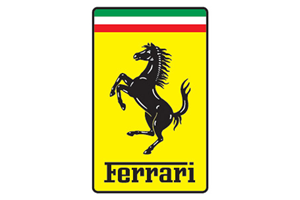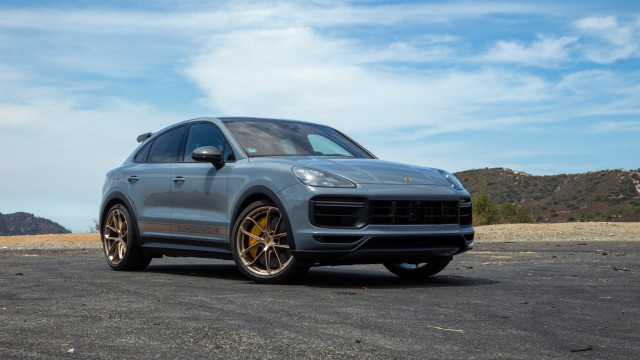


This edition of the Ferrari F50 4.7 V12 is the 6 speed / Manual version and was first brought out in 1995. This was at around the same time as the introduction of the 1996 Ferrari F50 GT1 4.7l V12 and the 1995 McLaren F1 LM 6.1 V12.This particular Ferrari F50 has a 4698cc Naturally Aspirated Petrol powerplant with 12 cylinders in a V formation.
The F50 shares its Petrol V12 engine configuration with the likes of the 2021 Aston-Martin Valkyrie Spider 6.5 V12 and the 2021 Aston-Martin Valkyrie Coupe 6.5 V12. If you're looking for other fast cars which share the F50's Rear Wheel Drive, Coupe combination then how about the 1982 Fiat X1/9 1.5 8V or the 1965 Aston-Martin DB6 1965.
Weighing in at 1230 kgs (2711 lbs) this makes the Ferrari F50 4.7 V12 in the same weight category as the 2020 Audi A1 A1 Sportback 35 TFSI S tronic S line or the give or take 50kg.
![Bentley Continental GT 4.0 V8 Turbo Convertible - [3996] image Bentley Continental GT 4.0 V8 Turbo Convertible - [3996] image](/editionimages/2058.jpg)
The Ferrari F50 shares the same bhp with the 3996 Bentley Continental GT 4.0 V8 Turbo Convertible (542 bhp)
In terms of power the 4698cc 60V V12 engine produces 520 bhp (387 kW) @ 8000 rpm similar to the 3996 Bentley Continental GT 4.0 V8 Turbo Convertible (542 bhp) or the 2024 Ford Mustang Dark Horse 5.0 V8 (500 bhp).
The Naturally Aspirated V12 throws out 347 lb-ft (470.4 Nm) @ 6500 rpm placing it with cars of similar torque performance figures such as the 2024 Mazda CX-90 S 3.3 Turbo (369 lb-ft) or the 2023 Porsche Boxster Spyder RS 4.0 982 (332 lb-ft).
If one combines the weight with power or torque performance for the Ferrari F50 you can get a better idea of it's real world performance.
![McLaren 625C Spider 3.8 V8 Twin Turbo - [2014] image McLaren 625C Spider 3.8 V8 Twin Turbo - [2014] image](/editionimages/1658.jpg)
The 2014 McLaren 625C Spider 3.8 V8 Twin Turbo (447.6 bhp per ton) has similar Bhp Per Ton stats as the Ferrari F50.
The Ferrari F50 has a Power to weight ratio of 422.7 bhp per ton and 282.1 lb-ft per ton. Bhp Per Ton figures of the 1995 F50 competing with the 2014 McLaren 625C Spider 3.8 V8 Twin Turbo (447.6 bhp per ton) or the 2017 Porsche 911 GT2 RS (446.6 bhp per ton).
If you agree with the late great Carroll Shelby then arguably an even better indicator of potential performance, Torque. Use weight as well and you end up with - Torque per ton, with the Ferrari F50 generating around 282.1 lb-ft per ton. If you're curious as to what other cars have as much torque to weight then look no further than the 2014 Tesla Model S P85D (306.8 lb-ft per ton) or the 1970 Plymouth Barracuda 440 (306.8 lb-ft per ton).
With a 0-60mph time of 3.70 secs or a 0-100km/h (0-62mph) of 3.8 secs, this made the Ferrari F50 4.7 V12 as fast as the 2022 Ford Mustang Shelby GT500 (3.70 secs) the 2022 BMW 8 Series M850i xDrive 4.4 V8 Turbo G15 (3.70 secs) the 2021 Porsche 911 GT3 992 (3.70 secs) the or the 2021 Chevrolet Camaro ZL1 6.2 V8 Supercharged Convertible (3.70 secs). This Ferrari F50 4.7 V12 is also faster than the 2023 BMW X5 M Competition 4.4 Turbo F95 (3.80 secs) the 2022 Porsche 911 Carrera T 3.0 Turbo PDK 992 (3.80 secs) the 2021 BMW i4 M50 (3.80 secs) the and the 2021 Mercedes SL Class 55 4Matic+ 4.0 V8 Twin Turbo (3.80 secs).
When talking about the performance of the Ferrari F50 on the drag strip it can reach a quarter mile in an estimated 10.92 secs @ 125.2 mph. Similar performance down the quarter mile can be found with the the 2014 Porsche 911 Targa 4 991 (10.87 secs), the 2008 Mercedes SL Class 63 AMG V8 R230 (10.88 secs), and the 2010 BMW 3 Series M3 Coupe Frozen Edition E92 (10.89 secs).
Modern performance cars are often artificially restricted to 155mph. The 1995 version of the Ferrari F50 4.7 V12 has a maximum speed of 202mph.
If maxing out your car on the AutoBahn is your thing and you're wondering what's faster than the 1995 Ferrari F50 4.7 V12 then how about the 2005 Pagani Zonda F (214 mph), the 2006 Ascari A10 5.0 V8 (215 mph), or the 2017 Ford GT 3.5 V6 Bi-Turbo (216 mph).










Ferrari F50 GT1 4.7l V12
Engine: Naturally Aspirated Petrol | 4698cc 60v V12
Top Speed: 234 mph
0-60mph: 2.90 seconds

Seat Leon ST Cupra 265
Engine: Turbo Petrol | 1984cc 16v St4
Top Speed: 249.4 kph
0-100kph: 6.2 seconds



















